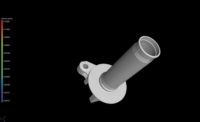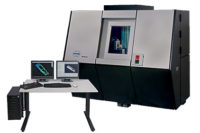
In the target/actual situation comparison, deviations between CAD data and the data measured with the help of computed tomography are depicted in a color-coded manner. Source: Yxlon
In the world of industry, 3-D X-ray computed tomography is used regularly for quality control and assurance in the course of quality management, as well as for process optimization. Previously, the area of application had been limited to the nondestructive testing of materials so that flaws and defects could be localized. These days, however, computed tomography is increasingly advancing into the field of industrial measurement technology. The rising acceptance of computed tomography as a means of measurement can be partly attributed to its growing degree of widespread usage. In addition, rapid technological advances in the development of X-ray tubes and detectors now enable reliable and highly accurate metrology results.

In the 3-D view, GD&T are analyzed and depicted in compliance with the DIN ISO 1101 standard. Source: Yxlon
Computed Tomography Tasks
The process of computed tomography can resolve a wide range of measurement tasks. Frequently, the surveying of outer component structures is not the only point of interest: The geometry of inner structures, such as cooling channels inside turbine blades or boreholes in aluminum die-cast parts, pose a focal point too. With the help of computed tomography, the specified geometric dimensioning and tolerancing (GD&T) of inner structures can be inspected precisely where they occur in applications dealing with bore alignments or the residual wall thicknesses of hollow bodies. Above and beyond these, computed tomography makes it possible to measure the surface of softer materials, and thus their GD&T, without making contact. Unlike optical or contact scanning methods, the type of surface involved here only plays a slight role.A high density of data points generated via computed tomography guarantees a precise, highly detailed depiction of the given surface. The data supplies extensive information on the GD&T defined by engineering, and thus regarding the permissible tolerances themselves. This, in turn, allows the functionally relevant attributes of inspection items to be ascertained with assurance. If the CAD data are then used to additionally perform a comparison of the target and actual situations for the data supplied, the high density of data points on the surface provides a dependable statement regarding dimensioning deviances. One practical example of this is the detection of a core displacement in foundry technology. Besides this, comparisons of the actual state at a given time and over a defined time frame within the ongoing production process enables alterations in dimensioning to be monitored and displayed.
The X-ray tube, the detector and the manipulator must be configured correctly for the application to obtain optimum measurement results. Industrial deployment has shown that the combination of an X-ray source with a variable focal spot and a 16-bit flat-panel detector is best suited to meet multifaceted challenges and supply the most accurate measurement results. Depending on the specification involved, a micro-focus tube or a sealed variable-focus tube can be used for this purpose.
The variable-focus tube has an output of 250 watts at an effective focal-spot size of approximately 80 microns. The focal spot can be adjusted variably to adapt to the inspection task. Magnifications that cover a large number of industrial applications are possible. At an output of up to 1,600 watts, the variable-focus tube scans at the greatest possible speed using the previously mentioned variably adaptable focal spot, yet without having increased image noise impair the quality of the data, and thus the resulting GD&T measurement results. In contrast, micro-focus tubes with multi-focus technology (MFT) are predominantly employed for applications that demand a much higher resolution.

By being equipped with an X-ray tube, new, modern computer tomographs unite a compact construction design with a wide range of applications. Source: Yxlon
Technology Evolves
The gap between the micro-focus tube and conventional X-ray tubes has been closed through the evolution of micro-focus technology on the one hand, and the development of variable-focus technology on the other. In addition, an automatic dose stabilization technology creates the prerequisites that enable precise GD&T measurements to be conducted using micro-focus tubes, ensuring the constant measurement conditions that are imperative for achieving a high degree of precision.When outstanding image quality is called for, the flat-panel detector plays a decisive role in computed tomography alongside the X-ray tube. The flat-panel detector fulfills all the requirements necessary for obtaining exact measurement results. In addition to 16-bit technology as standard and large areas for gray scale or contrast, the detector has a highly dynamic radioscopic range that guarantees high metrological precision and high detail detection. This is a key factor for measurement tasks in the field of computed tomography because both the thickest spots and the thinnest areas of a given inspection item must lie within the scope of dynamics for each projection.
Together with computed tomography software, computers equipped with constantly growing output and high-performance graphic cards enable a reconstruction of 3-D datasets within three to 15 minutes. This applies to all typical applications.

Cross-sections can be laid at any positions desired due to the 3-D data. As a result, the dimensions important to the function involved can be analyzed optimally and a documentation of the analysis can be created analogous to the construction blueprint. Source: Yxlon
Software Developments
What is new is the processing of voxel datasets with a simultaneous analysis of GD&T on a single software platform. This omits complex data conversion and further processing using diverse software packages. Data relevant to analysis, whether as indicators pertaining to GD&T or toward analyzing material flaws, are depicted clearly structured in the 3-D dataset and archived in logs.Some providers offer computer tomographs alternately as the solution for a radiation protection bunker or in a shielded cabinet. Both meet all the requirements for protection against radiation. In addition, extensive failsafe safeguards provide for safe working conditions at all times.
Assisted by computed tomography, technology for tubes and detectors now makes it possible to measure GD&T quickly and without contact. In contrast to other procedures, interior and undercut geometries also can be measured.
Ample areas for deployment suggest themselves, whether in prototyping, quality assurance, production monitoring or process optimization-both in industry itself and for service providers in testing and inspection. Today, industrial computed tomography using X-rays is already being used on a regular basis for the nondestructive testing of materials. In the future, industrial computed tomography using X-rays is going to conquer even more fields for task solving and additional branches. Its appeal will increase as companies will be able to rapidly amortize their investment costs due to the broad range for deployment. NDT


